
As expected, there was no debate at Portland City Council yesterday where an ordinance to authorize a new 20 mph residential speed limit was on the agenda.
Getting a 5-0 vote in support was a foregone conclusion because the state law council endorsed was crafted by the City of Portland in the first place. Lower speed limits are also a key pillar of Portland’s Vision Zero plans.
When there’s no real drama, council meetings like yesterday’s are often most useful because they give us a window into what our electeds, city staff, and other community leaders think about the policies we obsess about around here all the time.
Before I share a selection of comments and testimony I heard yesterday, let’s take a look at the technical aspects of the 25 mph –> 20 mph rollout the Portland Bureau of Transportation will now get started on in earnest:
The official details from PBOT
PBOT project manager Dana Dickman presented the plans to council. She described the places where the new 20 mph speed limit will take effect as, “the streets most of us live on,” and “our collective front yard.” Dickman also shared that this speed reduction effort is the second of three speed-related actions outlined in PBOT’s Vision Zero Action Plan. The first one was to install speed safety cameras (which they’ve done to great success) and the next one is to redesign streets so they’re harder to speed on.
What exactly are “residential streets” according to PBOT? Dickman shared a definition that included the following three criteria:
1. Excludes federally classified collectors and arterials.
2. Has a “statutory speed limit.” [This means a limit where state law defines the speed and it doesn’t have to be signed in order to be enforced. Places where PBOT or ODOT have created a special “speed zone” with signage do not apply.]
3. Located in a “residence district.” [That term is defined in ORS 801.430 as, “territory not comprising a business district that is contiguous to a highway that: (1) Has access to property occupied primarily by multifamily dwellings; or (2) Has an average of 150 feet or less between accesses or approaches to: (a) Dwellings, churches, public parks within cities or other residential service facilities; or (b) Dwellings and buildings used for business.]
Dickman pointed out that some streets — like SE Belmont at 15th — will remain 25 mph even though they go through residence districts.
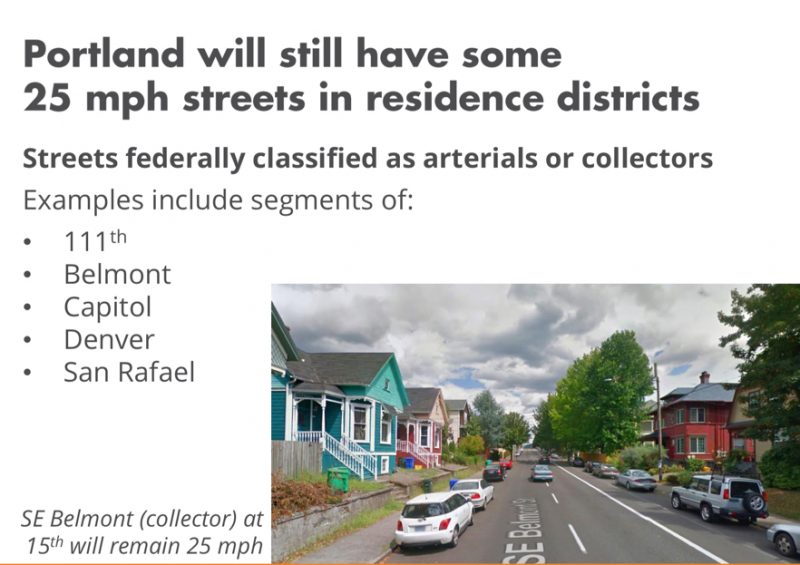
PBOT has just updated their website with Dickman’s entire presentation and a much more detailed map of the new 20 mph streets:
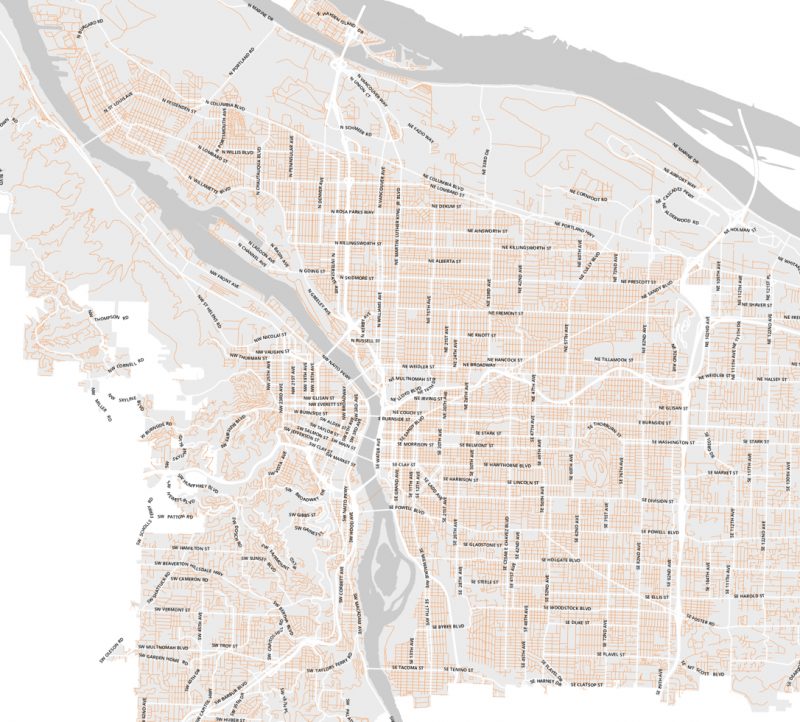
And here’s a look at the streets that won’t get lower speeds:
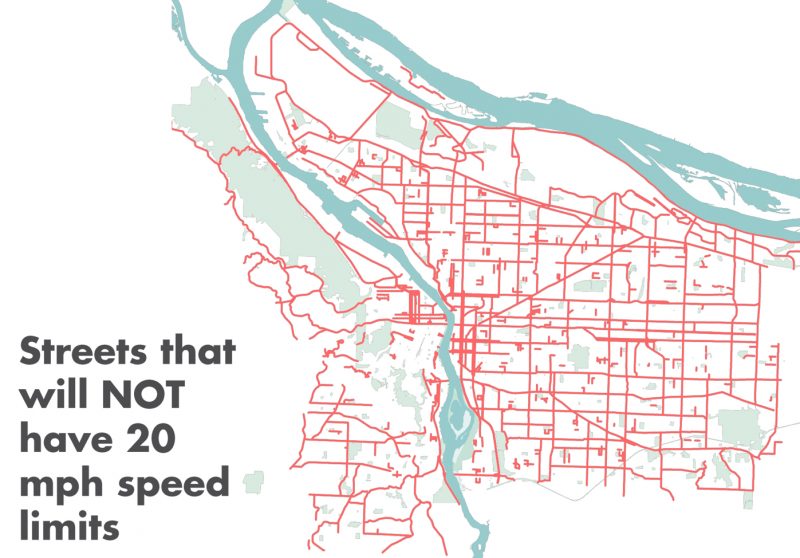
If you’re wondering when all signs will be changed and the lower speed limit will be in effect citywide, here’s a timeline:
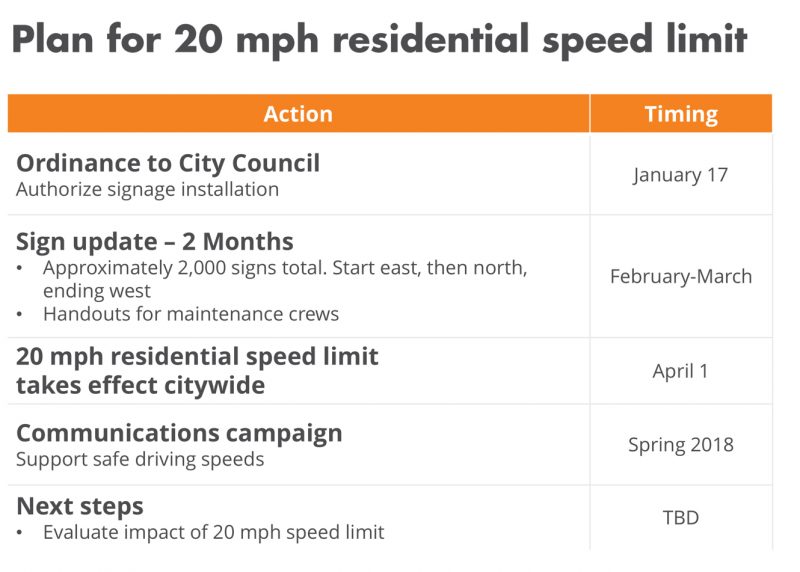
Advertisement
What they said
Noteworthy commentary from electeds and leaders.
PBOT Director Leah Treat:
“This is a really significant step… This is primarily about safety, but benefits go beyond that. Our residential streets are not just for cars to travel on, they’re where we play basketball, people have block parties, walk to the library… This is about making our streets more livable…
In 2017 45 people were killed by traffic violence in our city; an unfortuhabate upward tick in our fatalities and we want to address that.”
Commissioner Amanda Fritz:
“I have lost three family members to traffic crashes involving speed… To people who say this won’t work: It might. And I would ask everyone who drives: Do you want to be a driver who causes a fatlity?
… There’s a reason for speed limits. I believe that most Portlanders do the right thing if they do what they’re supposed to do, and it’s defintely the right thing to do to drive 20 mph on residential streets.”
Commissioner Nick Fish:
“What we’re talking about in preventing unnecessary deaths on our streets and arterials, is preventing families from being torn apart by the tragedy of a completely preventable death… We know there’s a problem and there’s lots of ways to fix the problem. The question is: do we have the will to implement them? We can argue about whether it’s 20 or 25 or what level enforcement… but my view on Vision Zero is: Let’s take all the best ideas and implement them. Because if we save a life — if we save someone the horror of burying a loved one — we’ve done something important.
… As to the notion that we can’t change behavior. I think we do it through peer pressure and community pressure. How about setting an example? Like put your goddamn phone down while you drive!”
Mayor Ted Wheeler:
“… I believe this is an important step towards reducing the kinds of interactions we’re having on our streets that are leading to some of the negative news stories about how safe our community actually is.
I know there will be those that will say: ‘This is the government intervening and trying to change our behavior.’ I want to be clear: they are exactly right! But the truth is, the government shouldn’t have to come in to change behavior. We shouldn’t have to be taking this action. The reason we are doing it is people aren’t using the two most valuable tools they have to reduce accidents and injuries on our streets: And that is a reasonable schedule and the clock that you need to make sure you are running on time. If you leave home late for someting you have scheduled you are going to drive faster than you need to. I think the communications program is: Have a resonable schedule; know how long it takes you to get from point-a to point-b and leave on time. Don’t leave late. So many of these accidents, people say, ‘Gosh, I didn’t mean to run this person over, I was running late.’ That is epidemic in our society. We are always overscheduled. We are always running late. And the busier and later you are, the more you are not thinking about what you should be thinking about, which is driving the car and doing so in a safe manner.
So this is one tool we are using, but the most important tool is ulimately the decisions we make as drivers before — and while — we get behind the wheel of an automobile.”
A note about enforcement
There’s been much debate here about how enforcement will — or won’t — play a role.
“I can’t tell you I’m going to increase enforcement on these streets. Enforcement will stay about the same.”
— Michael Crebs, PPB Traffic Division Captain
From a policy standpoint, PBOT’s Vision Zero Task Force specifically de-emphasized enforcement due to how it might have an unfair impact on people of color and people. Here’s the language from the adopted plan: “The enforcement actions in this plan are limited in order to reduce the possibility of racial profiling and disparate economic impacts.” That doesn’t mean PBOT can’t use enforcement as a tool. The plan called for “targeted enforcement” to “address violations that cause injury and death.” They called on the city to “de-emphasize less serious infractions.” Is speeding on residential streets considered “less serious”? That probably depends on who you ask.
At council yesterday, Portland Police Bureau Traffic Division Cpt. Michael Crebs said, “I support this 100 percent… this is a big deal folks.” He said he too is concerned about enforcement. While enforcement will continue on high crash corridors, Cpt. Crebs said, “I can’t tell you I’m going to increase enforcement on these streets. Enforcement will stay about the same.” Even so, he thinks the law will slow people down. Crebs also said he believes “the majority of folks” who drive on residential streets are “your friends and neighbors” and that peer pressure alone will be enough to slow them down. I’m not sure where Cpt. Crebs lives, but in Portland right now the big problem is the opposite: People are using residential streets as cut-throughs and they don’t care about anything else but getting home a few minutes faster.
Commissioner Fish also shared a concern that enforcement wasn’t part of the speed reduction plan. PBOT’s Dickman told him, “Our intent is to stay true to the strategy for enforcememt we have now.”
By April 1st, PBOT should have all the new 20 mph signs up. It will cost them about $300,000 to pay for labor and materials.
— Jonathan Maus: (503) 706-8804, @jonathan_maus on Twitter and jonathan@bikeportland.org
Never miss a story. Sign-up for the daily BP Headlines email.
BikePortland needs your support.



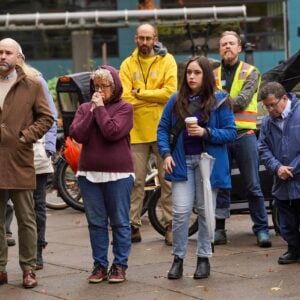

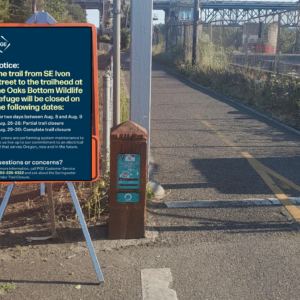
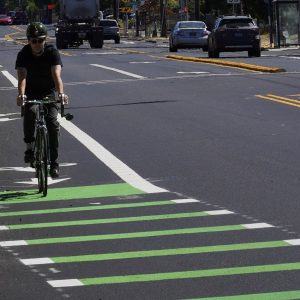
Thanks for reading.
BikePortland has served this community with independent community journalism since 2005. We rely on subscriptions from readers like you to survive. Your financial support is vital in keeping this valuable resource alive and well.
Please subscribe today to strengthen and expand our work.
I am puzzling over this statement, ” Dickman also shared that this speed reduction effort is the second of three speed-related actions outlined in PBOT’s Vision Zero Action Plan. The first one was to install speed safety cameras (which they’ve done to great success) ”
Are all these successful speed safety cameras located in an alternate reality, “Bizzaro” Portland, or have I just missed them, especially the success part.
Hi bikeninja,
PBOT has installed several of them (and more are coming). So far the results have been very promising.
It will be interesting to see the impact this has. As someone who lives on a street that won’t see a lowered limit, my impression is that where the new limits do and do not apply makes sense overall.
However, it is also my general sense that the new limits tend to apply in places where people usually drive slowly and those who don’t probably wouldn’t obey whatever limit is there.
In any case, it’s good to have more sensible posted limits. Even 20 is too high on some of the narrow streets with poor visibility, even on a bike.
I’m shocked that some streets in the SW Hills are not on the list of 20 mph streets.
Thanks for the follow-up. From the PBoT map…it looks like the PDX airport will be safer with its boundary street now at 20 mph. ;-/
I love salty fish.
Like Bacalao?
Lincoln/Harrison is not on the 20mph map. Why not?
Lincoln?Harrison & SE41st/42nd (south of Powell) were “upgraded” by PBOT (probably by Geller) so that they would be more eligible for roadway upgrades during years of plenty, and less likely to be abandoned during years of budget cuts. The city has to submit to the feds (and ODOT/Metro) something known as a “functional street classification”, which has a cascading hierarchy of roadways (few highways, twice as many arterial roads, 4 times as many collectors, etc), which the city largely bases off the TSP traffic classifications. I remember some of the bike staff convincing others of the merit of “upgrading” some of the bikeways to “collector” status, even though the streets were largely “local” and had low traffic volume, during the last period of huge budget cuts (2010-13), so that the bike streets could be still maintained even as other services were being drastically cut.
I don’t know their posted speed limits, but I do expect these will be among the streets that PBOT will be actively experimenting on for VZ Phase 3 engineering upgrades.
The section of Harrison that is currently a Neighborhood Collector (26th to 30th) will be downgraded to a Local Traffic Street, when the Comprehensive Plan and TSP take effect, which is now said to be May 24th, 2018. Also downgraded will be 26th from Division to Harrison, and 30th from Harrison to Hawthorne.
Federal Functional Classification System is what the ORS is based on and there is little alignment with City Traffic Classification.
I wonder if PBoT will actually be “raising” the ‘legal’ speed on many residential streets by increasing the number of posted signs (2,000 signs vs ~1000 existing)…if one applies the basic speed rule (15 mph in narrow residential streets) to the unposted streets that might now get signed? [A potential unintended outcome if they are not careful?!]
The more signs you have, the more likely drivers will “zone the visual noise out” and ignore them, as with internet ads and personal-injury lawyer ads on billboards. PBOT knows this very well and applies certain sign-placing principles that balance sign-frequency with maintenance costs.
Could you repeat that? I zoned out for a minute.
Ms. Dickman’s seemingly nice words exclude much of Portland’s residents. According to that map, my street will not be getting a lower speed limit despite it being a local service street and passing by a school (it’s currently posted at 30 MPH). This is truly a symbolic gesture that does nothing to address Vision Zero, as most fatal or serious crashes occur on arterial streets and intersections – none of which are getting a speed reduction. City Counselors get to pat themselves on the pack for “addressing safety” while us normal folks still struggle with increasingly dangerous streets. Thanks for nothing.
Why are any local service streets posted higher than 25?
Good question.
Seriously, I’ve been trying to get an answer from PBOT for years and have yet to get anything definitive other than “sometimes streets don’t match their official designation”.
It’s ODOT’s standard. Residential streets in the State of Oregon are set to have 25mph speed limit by default. The only reason PBOT can lower the speed limit from 25 to 20 is because HB 2682 “authorizes City of Portland to designate speed that is five miles per hour lower than statutory speed when highway is located in residence district and highway is not arterial highway”.
http://www.oregon.gov/ODOT/Engineering/TRSDocs/Speed-Zone-Brochure.pdf
https://gov.oregonlive.com/bill/2017/HB2682/
That doesn’t explain why a residential street would be posted at 30 mph though.
Which street, and from where to where?
Klick,
‘your street’, care to be brave enough to name it?
‘Local Service’ is an official City Traffic Classification, not your perception of reality.
But if a street is classified as Local Service, we should treat it as such.
Vancouver has many, many residential streets with 30mph speed limits–one in my neighborhood is narrow, very badly lit, and has no sidewalks plus a normal speed by residents of 35-45 mph despite the signed speed. I pretend to be European when I drive it–and take it at 30 KPH.
I agree with your assessment of the safety impact. However, this change affecting “most” but not affecting “many” is not a contradiction. It clearly affects well beyond 50% of streets. Of course, even 10% left out (made up number) is still lots of people.
Too bad that most cruise controls won’t work under 25mph.
Using cruise control in a neighborhood setting is nuts.
You use cruise control on some of the streets noted on the map above? Which ones? Why?
To use their smart phone without being distracted with driving, why else?
Mine works at 20. More modern cars can.
Is it actually true that “most” Portlanders live on the affected streets? Seems like there are a lot of folks who live in apartment buildings on arterials.
There are many illegal/nonconforming multifamily buildings in residential areas. I live in one and so do that vast majority of my neighbors.
Non-conforming buildings are perfectly legal.
April 1st seems to be a bad date for rolling this out. Lot’s of comments about April’s fool day. 🙂
SE Gladstone and SE 41st near SE Steele really stick out to me on this map. These streets are wide since they are old streetcar streets, but now currently don’t even support bus service, and city has done everything they can do slow them down with speed bumps, islands, etc, but wonder why they don’t move to re-classify them so they can set the limits at 20.
B,
Gladstone and 41st are both Local Service streets.
OK, two more substantive comment:
1. The comment by Amanda Fritz: “it’s defintely the right thing to do to drive 20 mph on residential streets.” inadvertently shows the norm that “speed limit = expected speed”, which I think is a really bad norm. The right thing is obviously to drive no more / less than 20mph on these streets! I would like to encourage the city to emphasize in their educational piece that a speed limit set the upper boundary of what you are supposed to drive on these streets and that driving slower is better.
2. Wheeler’s comment on scheduling ring a bell for me. One less obvious benefit of using a bike is that it is really hard to run late — it is simply physically strenuous, to go faster than your normal speed.
There are inconsistencies between the two maps. In my neighborhood, several streets or parts of streets are on both the “will be 20 mph” map and the “will not be 20 mph” map.
To whom should we direct comments about the maps and whether a given street or part of a street should be signed 20 mph?
Email dana.dickman@portlandoregon.gov
Thanks!
Can the second map be posted as a clickable PDF?
What about school zones?
What about them?
Streets with school zones will get new signs outside the school zones, but the school zones will remain because fines are higher in schools zones when in effect.
I’m in a school zone with a 25mph posted speed. I hope PBOT sees the importance of changing it. Would be nice to have some ADA curb ramps leading into the school facility also. Maybe a crosswalk too.
“Enforcement will stay about the same.” Even so, he thinks the law will slow people down. Crebs also said he believes “the majority of folks” who drive on residential streets are “your friends and neighbors” and that peer pressure alone will be enough to slow them down.”
He seriously cannot be that ignorant. He must know how much of a problem we have with people speeding and Wazing their ways through residential areas (as you point out, Jonathan). Why be so disingenuous? Just say no money will be dedicated to enforcement. Don’t gaslight and brightside us all to death. It really is too much, at this point. It’s clear by now that no money will ever be dedicated to enforcement. What on gud’s green earth will it take for this city to start enforcing traffic, and other, laws?
We have a BIG PROBLEM with several issues in neighborhoods, directly related to a lack of enforcement. People have learned they can break laws with impunity because they will not be held to account for their actions. This is one of the reasons I and mine moved away recently. The 20mph speed limit is toothless if there is no enforcement of the law.
I would never underestimate the levels of peoples’ ignorance. And I am certain people would say the same about mine 🙂
Most studies of local streets, the small ones, not the Lincolns and Clintons, find the majority of users are from the local neighborhood.
They’ve already lowered the speed limits… there are many other reasons that are being ignored as to why there are pedestrian accidents. See the stories with links below:
1) “Although drivers are legally responsible for controlling their vehicle at all times, the majority of pedestrian accidents are caused by pedestrian actions.” FULL STORY. https://www.trafficsafetystore.com/blog/why-people-get-hit-eight-causes-of-pedestrian-accidents/ Please note that this story is a few years old and I think it is fair to say BOTH drivers and pedestrians are more distracted by electronics, but for some reason there is only a campaign for drivers.
— things like half of fatalities include pedestrians wearing only dark clothes… road layouts… intersections, etc. 13% of fatalities include a drunk driver, but 37% include a pedestrian with blood alcohol over .08.
2) Ranked: Most Dangerous U.S. Metros for Pedestrians: https://nextcity.org/daily/entry/dangerous-cities-walking-pedestrian-safety-study-2016 . Portland is actually a pretty safe city in the top 100, but without going into too much detail here, it is important to note that some cities that have higher speed and more congestion are doing better than Portland, like NYC & Chicago.
— There is a lot of data here including speed is a factor in 1/3 of fatalities, but it may not be the only factor, and that also means 2/3 of fatalities have nothing to do with speed.
Using the information from the above two stories (which are both sourced), I think it is fair to draw the conclusion that trying to solve this problem with only speeding is fooling ourselves. There are way too many variables that aren’t being addressed, or at least don’t seem as though they are being addressed.
I’d rather they do things like spending money on lit crossings with flashers and medians than new speed limit signs.
Read the text of the new law, ORS 810.180, new section 11:
(11) The City of Portland may establish by ordinance a designated speed for a highway under the jurisdiction of the city that is five miles per hour lower than the statutory speed.
The following apply to the authority granted under this subsection:
(a) The highway is located in a residence district.
(b) The highway is not an arterial highway. *this is federal functional classification*
(c) The city shall post a sign giving notice of the designated speed at each end of the
portion of highway where the designated speed is imposed and at such other places on the highway as may be necessary to inform the public. The designated speed shall be effective when signs giving notice of the designated speed are posted.
After an ordinance
Only residence district streets
If not Federal Functional ‘arterial’ (collectors and local are lower FFCS classifications)
Existing statutory (25 mph, posted or not)
After new signs posted each end of each highway (road)
Then enforceable
“The enforcement actions in this plan are limited in order to reduce the possibility of racial profiling and disparate economic impacts.”
Wait… so… we can make laws to protect people, but we can’t enforce them because our police are too racist? I hope that’s not what is really going on.
The law clearly, on its face, includes collectors.
Federal Functional Classification System minor and major Collectors, yes.
>> How about setting an example? Like put your goddamn phone down while you drive!”
The most intelligent words I’ve ever heard out of city council
>>From a policy standpoint, PBOT’s Vision Zero Task Force specifically de-emphasized enforcement due to how it might have an unfair impact on people of color and people.
The most asinine thing I’ve ever read from PBOT
“let’s make a law and not enforce it” .. why even bother ?
>> and people ????
Equity can seem unfair to those that have benefited from past inequity.
Yay pbot – this is going to save lives!